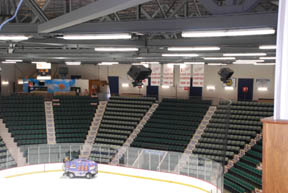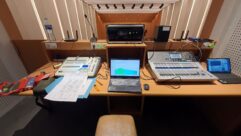
SVC Podcast – Show Notes – Show 175-1
In this edition of the SVC Podcast, Contributing Editor Bennett Liles talks with Seth Waltz of AVL Designs in Penfield, New York about their new sound system design for the Glens Falls Civic Center in upstate New York. He explains how they dealt with both budget and rigging restrictions to provide a system with fourteen Danley SH95 speakers power by Ashly amplifiers.
For Part 2
Links of interest:
Download Podcast Here:
https://s3.amazonaws.com/nb-svc/public/public/175-1_Glens_Falls_AVL_Desi…
This is the SVC Podcast from Sound & Video Contractor Magazine with Seth Waltz of AVL Designs, Incorporated. Show notes and equipment links for the podcast are on the web site of Sound & Video Contractor Magazine at svconline.com.
There’s so much going on at the Glens Falls Civic Center in upstate New York the existing sound system was having trouble keeping up and they needed a new one. They called in AVL Designs Incorporated from nearby Rochester for a new design and now they have a system with Danley speakers that does it all. Seth Waltz is here to tell us all about it, next up on the SVC Podcast.
Seth, thanks very much for being with us on the SVC Podcast from AVL Designs, Incorporated in, I believe, it’s Penfield, New York.
That’s correct.
Okay, and that’s upstate I guess.
Yeah. We’re up near Rochester. We’re basically a suburb of Rochester.
So in addition to today’s project what sort of things do you do at AVL Designs?
Well, our company is primarily a theatrical company. So we do an awful lot of theater renovations, so we’ve probably got 10 or 12 theaters that we’re in the process of doing renovations on. We do not only audio, but we do acoustics, lighting, stage rigging. We do all of those areas. And recent stuff that came online, we also just did kind of an interesting police academy for the New York State police department – completely new multiple auditoriums that are connected with video, audio, cameras. And that just went online a couple of weeks ago. [Timestamp: 1:40]
And they called you to come up with a sound system design for the Glens Falls Civic Center.
Yep. It started out as a testing project initially and then it proceeded after testing. We established some issues and they decided they wanted to go for a new system. [Timestamp: 1:54]
Okay. And I don’t think that was their first idea but after you clarified the situation that’s the way they decided to go?
The way it went, we went up initially and did perceptual testing where we put on voice information. We just walked the arena and looked for what were noticeable intelligibility problems. Then we actually did RASTI PA testing to verify those with numbers and then created a model of the existing system to verify that a model would actually produce those results so we would be able to look at possible solutions; which they were initially just hoping we would add some things to their existing system. And after we started modeling it we realized that with the budget they had we really couldn’t do that. Just it wasn’t a viable option. Then they got into wanting to look at a replacement. [Timestamp: 2:39]
And what general type of system did they have that wasn’t working quite the way they wanted it to?
They had QSC WideLine line arrays. And they’d been put in a number of years back and the contractor who did it did it on a budget that was incredibly tight so my guess they covered everything they could for the money they had. But some of the problems of being a line array, there was no individual amplification or processing. Each array was one amplifier basically driving the entire array so you couldn’t modulate anything. You couldn’t control pattern coverage or frequency anywhere in the array. And they really should have used 12 boxes in an array. They used seven and there were basically four clusters that they should have put in that were not put in. So they stretched the coverage. It was way beyond normal and the reverb time of the room is in excess of four seconds. So you really can’t get away with it in a room like that. So and they were given a lot of parameters that we are not privy to, so I never like to critique anybody’s work. They were probably told hey, here’s where you can put things, here’s what you can do, here’s what you can’t do, and here’s your money and they probably did the best they could. I think they got a great value in their original system, but it just wasn’t doing the job after I think about five years. They determined they really wanted to do something to upgrade. [Timestamp: 3:55]
Were you on any sort of restriction on where you could run cabling or rig speakers?
We were in their minds and then we decided to ignore all of that and look at designing something to go where it really needed to go. The existing system was rigged off of steel directly where the steel happened to be. We decided to look at spaces being flexible and figure out where clusters should be and then figure out a way to rig them later, which they finally accepted that approach. It was something a little foreign to them. They were looking for it to be a typical, you know, just walk out on the beam and hang it right where it was. And we ended up with things that were irregularly spaced between structural steel. [Timestamp: 4:34]
I would think that’s a pretty common situation when a client decides they want something and they think is going to be easy and it turns out to be more involved than they thought.
Yeah. And things – the existing system they used to take down every time a touring show came in so they had it rigged in a way that it was easy to take down and we decided to design in a way that they would never have to take any new system down, whether it was line arrays or something else. So we pushed out to locations that were, like I said, not exactly simple for rigging, but they made more sense in the big picture. [Timestamp: 5:06]
They have a lot of different things going on in there. Obviously a lot of hockey games since this is the home of the Adirondack Thunder but there are plenty of other things, too.
Yep. The very first thing that happened in there was a WWF event which is kind of unique because we expected them to bring their own local PA for down on the ice because there was no ice coverage in this system design. There was no budget for it. And this system, even though it wasn’t aimed at the audience, everyone down there said they were getting intelligible audio and they liked the way it worked. So that was the first event and since then there’s been rodeos, circuses. They’ve got basketball series finals coming up, hockey. I guess they do some ice shows here and there. So it’s a whole variety of things that they do in this venue. And in some cases for concerts they said they wanted to be able to tie in so we gave them that ability to zone and delay and basically tie in where they need to. [Timestamp: 6:02]
Well, that in itself will save a lot of wear and tear on the sound system and the whole venue.
Exactly.
With the new sound system going in, did you keep any of the existing gear and incorporate it into the design?
Our new design turned out to be all new loudspeakers. We were going to reuse some of their amplifiers. We were providing a lot of new amplifiers because the layout just didn’t make sense for what we were doing. So there was a trade over period where the existing system was still running while they installed all the rigging and wiring for the new system. And they got all the speakers up for the new system before cutting the whole thing over. So the old system was able to stay in place because we weren’t rigging anywhere near it. So that was kind of a plus. They could work through their season that they were in without having to lose their system in the process. [Timestamp: 6:49]
Well, maybe that took a lot of the pressure off of your guys, too.
Off of us, no. The contractor who was doing the install was happy about it. It was the emergency kind of turnover until the day they actually made the final wiring changes. [Timestamp: 7:03]
And you decided to use Danley SH96’s for this?
Yep. We’d looked at a line array solution. We looked at adding WideLines since they were already there and we found the solution that worked well, but by the time we had enough processing amplifiers, clusters and extra speakers it was just way out of their budget. So we looked at some other people’s line arrays; couldn’t really find anything that made sense. We’ve had a lot of experience with Danley and Danley, some of their boxes cover a very large footprint with an awful lot of fidelity and a lot of output. So we did an array design with SH96’s alone and found that 14 clusters could cover the entire arena, but when we looked at where we had to rig them so they never had to take them down for a show it pushed them up into the seating enough that we ended up with some high-frequency dead spots right along with the glass for hockey. So we ended up taking some existing WideLine modules – we actually dropped them down 14 feet below the Danleys to get direct field coverage and time-delayed them and it worked extremely well. We’d had that all approved by the owner from a visual standpoint, but it actually did a great job of that. But we’re now going to be, as I understand it, this upgrade will be going through. They decided they didn’t want the QSC’s down there because a couple of season ticket holders didn’t like seeing that little module in their sight lines occasionally. So we’re now going to be taking Danley SBH-20’s and installing them up three feet below the SH96’s because they have a pattern that will allow us to get that amount of direct field behind the glass without any of those issues with sight lines. And the reason we didn’t do this originally was it was out of their budget. And then after the fact they saved money, I guess, on their video screens or some other factor and they said they thought they could afford to do that upgrade. So that’s being bid now. [Timestamp: 8:53]
Well, good luck on it. I’m sure that once they saw the speakers in place they decided that it would be best to just get everything up there where they would expect to see speakers.
Yeah. We’d done renderings for them, like 3-dimensional renderings. They accepted it all. The signed off on it. But when they did see it, a couple of people were immediately like, “Oh, that’s not going to work.” They really aren’t an obstruction for a hockey game because everything’s moving, but certain other events I can see where they might have issues. It was a budget-driven decision. We couldn’t find anything else that would get us that kind of direct field effect behind the glass without dropping the box way down because these things are 50 feet in the air to start with. And with the reverb time in the room we found we had to get it close to get it to work. But the SBH-20 is a product that has incredible pattern control. It behaves like a full line array all by itself and they’re just expensive enough that we never looked at using them initially because we knew that we couldn’t fit them in the budget. But we’re hoping that upgrade will make everybody happy because in hockey games with the whole audience behind you it’s pretty loud behind the glass and that’s about 3 dB down from the rest of the seating area because of the positioning of the SH96’s. [Timestamp: 10:04]
That’s a lot of different things but it IS the civic center. It’s interesting that you had a wrestling match to start things out.
Yeah, it was especially with a visiting sound guy. We had no idea what he was going to do. [Timestamp: 10:14]
Well, with the wrestling as long as the mat mics work it probably made the crowd happy.
That and the music. And they were thrilled because the last time they were there they couldn’t get any bass out of the WideLines because the WideLines really just don’t go down that low. And the SH96’s, without subwoofers, make an incredible amount of bass because there’s four 15’s in each box. [Timestamp: 10:35]
Well, that sounds like a big enough job and in Part 2 we’ll get into the mics, the mixer and the other gear used in the new sound system design there. It’s been fun having you here. It’s Seth Waltz with AVL Designs Incorporated in Penfield, New York. We’ll see you in Part 2.
Okay. Been nice talking to you.
Thanks for joining us on the SVC Podcast. Show notes and equipment links are on the website of Sound & Video Contractor Magazine at svconline.com. Next week we’ll be talking to Seth about the mics, mixer and the iPad control at the Glens Falls Civic Center. That’s next time on the next SVC Podcast.










